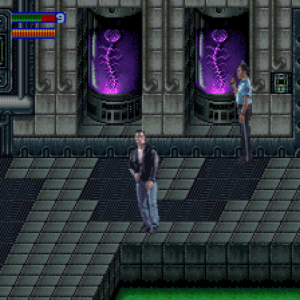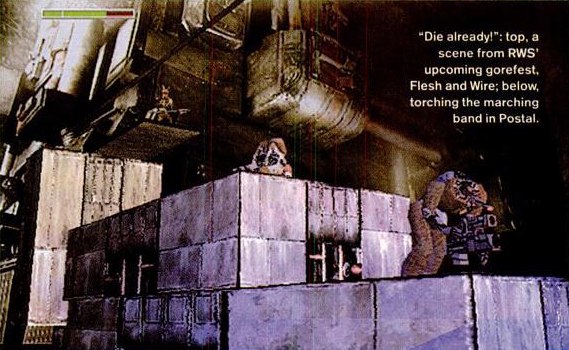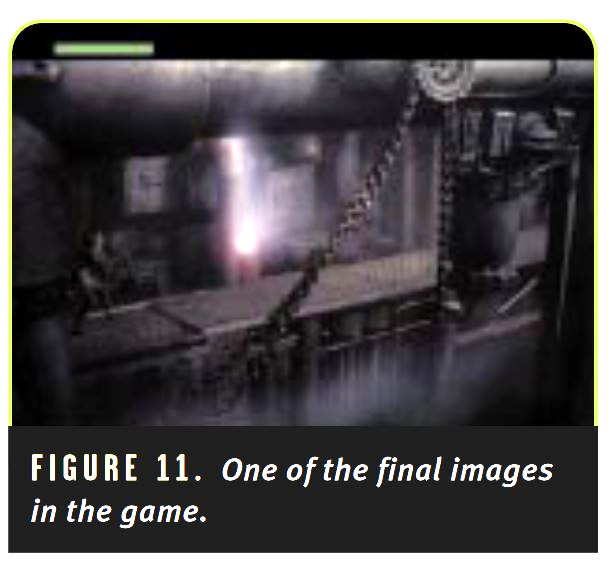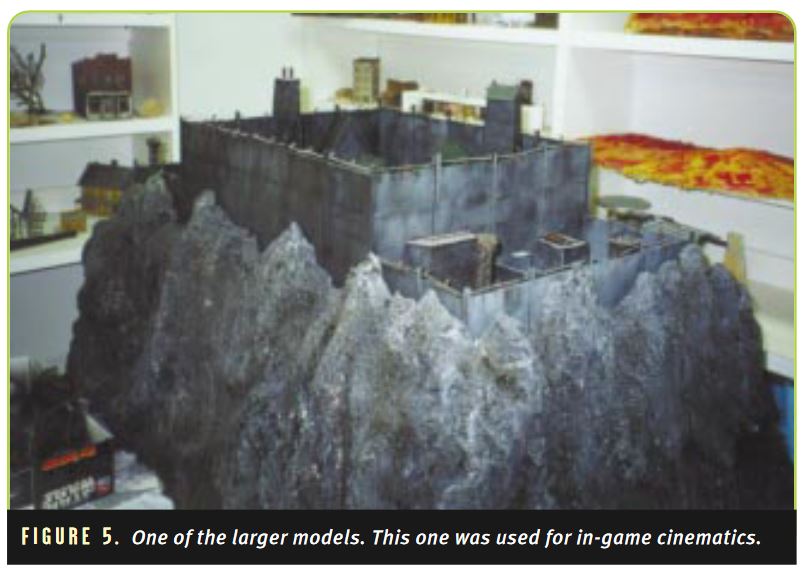Steven Seagal is The Final Option is a cancelled beat them up/brawler game developed from 1993 to 1995 for the SNES and the Genesis/MegaDrive by Riedel Software Productions, Inc., simply known as RSP, Inc. and today known as Running With Scissors, and published by TecMagik Entertainment. It features digitized graphics like the first Mortal Kombat games, alongside stealth mechanics, and was centered on the action movie star Steven Seagal.
The game was set in the future while Steven Seagal partnered with Trish Morgan in order to lead an ultimate assault on an evil corporation named Nanotech, which was responsible for the death of Steven’s former partner Jack Fremen:
Steven Seagal is a legendary runner, but commanders dislike his loose style and contempt for rules. His partner, Jack Fremen, was killer on their last mission. There is no evidence to support it, but many wonder if he might still be alive had Seagal followed orders.
Trish Morgan, another veteran runner, has been assigned as his new partner. She’s tough as any but has the attitude that commanders look for.
Now, the rebels will attempt the ultimate mission: an assault on Nanotech’s main campus.
High command nervous about Seagal – They know he’s out to avenge Fremen’s death. But he’s the best chance they have.
He’s the only choice…
The second main character, Trish Morgan, was also meant to be playable and would have different features than Steven Seagal. According to some source, she teamed up with Seagal in order to rescue her son, who was kidnapped by Nanotech.
It was officially announced by Jeff Tarr in an interview for The Hollywood Reporter in September 1993:
“There have been a lot of games based on movies, but not any that we know of based on a Hollywood celebrity.We have the rights to his name and his image, but we used a look-alike because the resolution of even digitized images on cartridges is not such that you can tell the difference.”
“Seagal still consulted extensively on the project and he received a [combination] of royalties and guarantees as his compensation.”
Daily Variety offered more of a look into the game’s motion-capture process.
“TecMagik shot much of the game at a Santa Monica studio using technology developed for compact disc platforms and a Hollywood-style production team that included a director/producer, actors, dancers, a choreographer and a costume designer. In four days of shooting, the company filmed more than 10,000 frames of Seagal’s aikido action.
Seagal’s involvement supposedly included “input into plot progression” and approval of the final product.
The Final Option’s release was slated for spring 1994. The game would appear on both the Super Nintendo and SEGA Genesis systems.
The following information comes from Nintendoplayer, who, over the years, managed to own a prototype of the game and explained how it works and plays:
The Final Option in its alpha form is essentially a bloodless beat-em-up brawler. The goal is simply to reach the exit and advance to the next level.
Decked out in his trademark leather jacket and blue jeans, Steven Seagal infiltrates the evil Nanotech’s laboratories and reactors in six dangerous missions, three stages per mission.
He can unleash Aikido chops and crotch kicks to anyone dumb enough to get in the way, or play really dirty by tossing an infinite supply of throwing knives or by pulling out a handgun when the action gets to be too much to handle. Seagal can also perform a combo move to throw thugs.
Health and more knives and ammunition can be picked up off the ground.
Seagal’s trademark fighting technique of standing in one place and waiting for punks to run into his fists has translated well into the gameplay. Lab technicians and crooked cops will dutifully form organized lines to receive their deserved beatings.
Enemy attacks range from kicks and punches that do minor amounts of damage (and can be blocked) to bullets that can take Seagal down with one hit. The player is given unlimited lives in the prototype, so difficulty is not an issue. (In fact, the only way that Seagal can lose is if he deliberately stays too long in one of the gas-filled rooms that have timers; that will result in a TIME UP.)
What is an issue, however, is Seagal’s inability to jump, as the big lug can only “crouch hop” short distances. Every stage has platforming or obstacles that need to be leapt over, but the best that Seagal can hope for in most cases is to let out a high-pitched yelp as he plummets down ditches, burns alive in fire pits, or disintegrates while drowning in pools of glowing-green acid.
Fortunately, to compensate, the player can navigate a cursor around to place Seagal back on safe ground after falling. During some especially dicey moving platform sections, the player will have to repeatedly resort to doomful diving in order to move forward. Seagal was never known for overly exerting himself in action sequences, and again, this game strives for realism.
Still on Nintendoplayer, an interview of former designer Steve Wik can be found. Many things that happened during the development was shared, and by the sound of it, looks like it was less than easy for the developers:
The game’s credits list you as an artist. What exactly were your duties?
Actually, I had more to do with the game design than the art. On the art end, I was the one who put together the animations from frames captured from laserdiscs of the actor footage. On the design end, I had key input into the whole concept of the game that would have involved optionally using stealth and distraction to sneak past enemies rather than just the standard walk-to-the-right-punching-endless-waves-of-guys kind of game.
Jeff Tarr, director of marketing for TecMagik, admitted to The Hollywood Reporter in 1993 that a Steven Seagal look-alike was used in the game instead of the actual actor because gamers would not be able to tell the difference. Tarr still insisted that the star “consulted extensively” on the project, having “input into plot progression” and final approval. How involved really was Seagal in the making of this game? Did you ever get to meet him or talk with him?
As far as I know, Seagal had no interest or involvement in this game. The real reason Seagal did not appear in the game was that TecMagik was too cheap to pay him! I never heard about him having any sort of approval on anything. As far as I was ever told, he sold his name and likeness, and that was the end of it. We certainly never had to pitch our design to him and never saw any feedback from him about it.
I understand that much of the game was shot at a Santa Monica studio. A director/producer, actors, dancers, a choreographer, and a costume designer were hired, and 10,000 frames of Seagal’s look-alike were filmed. Were you present during any of this? If so, could you describe the scene and what that whole process was like? It would also be interesting to know more about the actor who played Steven Seagal.
The actor who played Seagal was just some guy we found at the audition. He was tall enough and knew something about Aikido. But I’d need to see the prototype you’re looking at, because at first we were using footage of our art director Randy Briley, who used to compete in martial arts competitions and knew Aikido. I don’t know for sure when or if the final Seagal footage got implemented.
I helped design the character moves and actions, but I wasn’t at the shoot. The choreographer would have been Randy Briley. There were actually two shoots, and the explanation is kinda meandering and lengthy, but amusing:
When the project began, we were presented with a really terrible design that TecMagik had paid some other company to write up. It was based on a driving game engine that TecMagik happened to have access to. Yes, it began as a driving game! After some brutal jokes about how would you even know it’s Seagal–have his ponytail flapping out of the side window–we made short work of destroying that original design and convincing TecMagik to let us start our own from scratch.
The first producer TecMagik gave us was a woman who we were told got her job because she’d “graduated from Harvard School of Business” and “was formerly a bank manager.” Pretty much the first thing she made clear to us was that she’d never played a video game in her life. We foolishly thought that would work to our advantage and lead her to trust our knowledge and design instincts, but that wasn’t to be the case. In the end, she looked at our design with all the stealth mechanics and said, “Why are you doing all this? Why don’t you just make it like Streets of Rage 2? That game sold a million units, clearly it’s what the kids want!”
But we fought that battle and got to keep our “unnecessarily gameplay-filled” vision of the game. Relations with that producer got so heated that TecMagik switched her to a different project and gave us a new guy they’d just hired.
This new producer apparently got hired because he and some friends had developed some sort of strip poker game for PC. Anyway, this guy turned out to be even worse than the previous producer, and at one point he started criticizing the character designs in the footage, which we had already been using for months. He felt the characters needed to be more wild and freakish. Which is certainly true if you’re hand-drawing them, and we didn’t necessarily disagree with the idea of improving them, but doing the digitized Mortal Kombat thing is a different story, as he was soon to discover.
While the owner of TecMagik was out of town, this producer authorized, on his own, a new shoot for the enemy characters and supposedly paid his strip poker buddies and girlfriend a few grand in TecMagik money to do it.
First, the thing was clearly shot in someone’s garage. There was no green screen! The camera angle, distance to the character and lighting often changed per shot so nothing could possibly have been matched up. He had characters doing dive rolls and falls and jumps where they’d actually go partially out of frame! In some shots, lights and other items actually blocked the view of the characters. (…) It was a nightmare. Hilarious, though.
The prototype does not have Trish Morgan in it, but I assume that she was supposed to be controlled by the second player. Do you remember anything about this character, what she looked like, her special abilities, etc.?
Trish would have been very similar to Seagal in terms of abilities, weaker in hand-to-hand, but with more powerful weapons to compensate. We never got around to fleshing her out, I think the plan was to get beyond the prototype stage before putting effort into her. We were focused on getting Seagal himself playable.
The prototype is an early build, so all of the computer monitors say the same thing, many dead-ends block the way, and none of the levels can be completed. Could you go into some detail on how the final game would have played? For example, would Seagal have battled a boss at the end of each stage?
The idea was that there would be multiple paths for replayablilty. The level layouts would offer spots where the player could move into the background and sneak around in shadows as an option to combat. Blackthorne would eventually do something similar, though in our version you could still move right or left while hiding. We had ideas for situations like being able to kick one of those typical office chairs and make it roll past an enemy, which would distract him so you could get by or attack him from behind.
The boss events would have been more like Contra, with static emplacements launching projectile and beam attacks while enemies also came out to attack you and an occasional “super” version of an enemy type as a midboss. I don’t think we’d designed a final boss yet.
My prototype runs on the Super Nintendo, but apparently there were also plans to release Steven Seagal on the SEGA Genesis. Is that true? If so, was the game ever up and running on the Genesis?
Well, this calls for another lengthy and meandering answer… While we were developing the SNES version, another company was hired to develop the Genesis version semi-independently. The deal was we’d share the character footage with them, but beyond that, I think they were pretty free to diverge from our design at will.
Unlike RSP, which was in Arizona, the Genesis dev company was located literally across the street from TecMagik in San Francisco. As we discovered later, this provided them with lots of opportunity to play weird politics against us. The closest thing there ever was to a Genesis version up and running was the utterly bogus “prototype” they put together to show, I think, at CES. Basically, what they did was take the raw Seagal walking animation frames and put him on a black background. He was much larger than our working prototype version and had the benefit of all of the Genesis’ RAM and color palettes being applied to him. So, basically, he looked great, but anyone with the slightest clue knew there was no possible way he could look like that in a real game. The sample environments they showed were done the same way. They looked terrific, but that was because they were using all of the system’s resources to display a single screen image with no characters or anything else going on. It was totally fraudulent!
But this unscrupulous developer used it as a wedge to show how much “better” their team was. I think the guy was trying to get them to pull the project from us and give it to them. I have no idea how he would’ve eventually explained why the game ended up looking so much crappier than their “prototype.” We were never into playing that kind of bogus self-promotional game, we were totally focused on putting together functional gameplay.
The game was originally slated for a spring 1994 release until it was delayed to early 1995. Then it kind of disappeared. When was the game officially cancelled, and can you provide any insight into why development was finally shut down? Did you hear about or personally experience any problems related to the game’s development?
My understanding was that TecMagik simply ran out of money, but there may be a more interesting story about what was going on there. Publishers went out of business all the time, so we just kept rolling with our other projects.
Greg Goldsholl, who played Steven Seagal for the game told to Nintendoplayer that it shouldn’t have been made from the beginning:
(…) I told Steven Seagal I played him in the game. He said he hadn’t approved the game and they weren’t supposed to do it. (…)
Over the years, the source code of the prototype leaked on the internet.
Still according to Nintendoplayer, another game starring Seagal was planned by TecMagik, this time for the Playstation and the Nintendo 64 named Deadly Honor, although to this day, not much is known about this title, except a tidbit of information that we can read on the video game graveyard of Playstation Museum:
Deadly Honor
The Basics
Slap an action star’s name on a video game and people are bound to pay attention, at least at first. But the problem is that this game went through an SNES incarnation before it wandered into PlayStation and N64 development, and then it never came out for any of the systems. Deadly Honor was TecMagik’s upgrade from the SNES game, Steven Seagal is The Final Option, the company was working on. If Deadly Honor was to be somewhat along the lines of The Final Option, it would have placed you as Steven Seagal in a game loosely based on the star’s action films, such as Under Siege, Hard to Kill, Marked for Death, and so on. The game was to be an action game where you ran around doing a lot of damage. What’s notable about the game is that it was reportedly being created from digitized film footage and was to use AnimaTek’s Caviar technology – a surface pixel real-time rendering engine, to create realistic figure and object animations.
WHAT HAPPENED?
The game was in development for the SNES and supposedly had a couple of complete levels, however TecMagik announced Deadly Honor for the N64 and PlayStation, and you can guess where the SNES game went. Ironically, the N64 and PlayStation games never saw the light of day either.
Thanks to Nintendoplayer, Steve Wik and Greg Goldsholl!
Images:
Images from the Sega Genesis/MegaDrive version:
Video:





